Papers by Antonio Carapelli
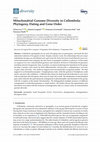
Diversity
Collembola (springtails) are an early diverging class of apterygotes, and mark the first substant... more Collembola (springtails) are an early diverging class of apterygotes, and mark the first substantial radiation of hexapods on land. Despite extensive work, the relationships between major collembolan lineages are still debated and, apart from the Early Devonian fossil Rhyniella praecursor, which demonstrates their antiquity, the time frame of springtail evolution is unknown. In this study, we sequence two new mitochondrial genomes and reanalyze all known Collembola mt-genomes, including selected metagenomic data, to produce an improved phylogenetic hypothesis for the group, develop a tentative time frame for their differentiation, and provide a comprehensive overview of gene order diversity. Our analyses support most taxonomically recognized entities. We find support for an Entomobryomorpha + Symphypleona clade, while the position of Neelipleona could not be assessed with confidence. A Silurian time frame for their basal diversification is recovered, with an indication that divergen...

Microorganisms, 2018
Protozoa, of the taxon Gregarinasina, are a heterogeneous group of Apicomplexa that includes ~160... more Protozoa, of the taxon Gregarinasina, are a heterogeneous group of Apicomplexa that includes ~1600 species. They are parasites of a large variety of both marine and terrestrial invertebrates, mainly annelids, arthropods and mollusks. Unlike coccidians and heamosporidians, gregarines have not proven to have a negative effect on human welfare; thus, they have been poorly investigated. This study focuses on the molecular identification and phylogeny of the gregarine species found in the midgut of two insect species that are considered as an alternative source of animal proteins for the human diet: the mealworm Tenebrio molitor, and the super-worm Zophobas atratus (Coleoptera: Tenebrionidae). Gregarine specimens were isolated from the gut of both larval and adult stages of T. molitor specimens, as well as from Z. atratus larvae. The morphological analyses were restricted to the identification of the different parasite morpho-types, likely corresponding either to different life-cycle stages or to alternative gregarine species. The samples were also used for the DNA extraction necessary for their genetic characterization. Finally, the efficiency of different molecular markers (i.e., 18S rDNA gene alone or combined with the Internal Transcribed Spacer 1) was assessed when applied either to gregarine species identification and to phylogenetic inference.

Genes, 2018
Leafminer insects of the genus Liriomyza are small flies whose larvae feed on the internal tissue... more Leafminer insects of the genus Liriomyza are small flies whose larvae feed on the internal tissue of some of the most important crop plants for the human diet. Several of these pest species are highly uniform from the morphological point of view, meaning molecular data represents the only reliable taxonomic tool useful to define cryptic boundaries. In this study, both mitochondrial and nuclear molecular markers have been applied to investigate the population genetics of some Tunisian populations of the polyphagous species Liriomyza cicerina, one of the most important pest of chickpea cultivars in the whole Mediterranean region. Molecular data have been collected on larvae isolated from chickpea, faba bean, and lentil leaves, and used for population genetics, phylogenetics, and species delimitation analyses. Results point toward high differentiation levels between specimens collected on the three different legume crops, which, according to the species delimitation methods, are also sufficient to define incipient species differentiation and cryptic species occurrence, apparently tied up with host choice. Genetic data have also been applied for a phylogenetic comparison among Liriomyza species, further confirming their decisive role in the systematic studies of the genus.
Zootaxa, 2018
The growing interest in Antarctic collembolan species has led us to re-evaluate both the morpholo... more The growing interest in Antarctic collembolan species has led us to re-evaluate both the morphological and molecular aspects
of different species adapted to the extreme Antarctic environment. The genus Folsomotoma includes nine species
mainly distributed in Antarctic and subantarctic areas and a few additionally from Australia and South America. We herein
designate the neotype of Folsomotoma octooculata (Willem 1901) and redescribe its morphological characters with particular
emphasis on the sensory and ordinary chaetotaxy. Furthermore, based on analyses of both our new and previously
published morphological data for F. octooculata, we propose a systematic key of the species for the genus.

Antarctic Science, 2017
Previous work focused on allozymes and mitochondrial haplotypes has detected high levels of
gene... more Previous work focused on allozymes and mitochondrial haplotypes has detected high levels of
genetic variability between Cryptopygus terranovus populations, a springtail species endemic to
Antarctica, until recently named Gressittacantha terranova. This study expands these biogeographical
surveys using additional analytical techniques, providing a denser haplotype dataset and a wider
sampling of localities. Specimens were collected from 11 sites across Victoria Land and sequenced for the
cytochrome c oxidase subunit I mitochondrial gene (cox1). Haplotypes were used for population
genetics, demographic, molecular clock and Bayesian phylogenetic analyses. Landscape distribution
and clustering of haplotypes were also examined for the first time in this species. Only three (out of 67)
haplotypes are shared among populations, suggesting high genetic structure and limited gene flow
between sites. As in previous studies, the population of Apostrophe Island has a closer genetic similarity
with those of the central sites, rather than with its neighbours. Molecular clock estimates point to early
differentiation of haplotypes in the late/mid-Miocene, also supporting the view that C. terranovus is a
relict species that survived on the Antarctic continent during the Last Glacial Maximum. The present
genetic composition of populations represents a mixture of ancient and more recent haplotypes,
sometimes occurring in the same localities.
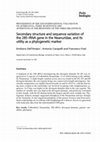
Pedobiologia, 2002
S Se ec co on nd da ar ry y s st tr ru uc ct tu ur re e a an nd d s se eq qu ue en nc ce e v va a... more S Se ec co on nd da ar ry y s st tr ru uc ct tu ur re e a an nd d s se eq qu ue en nc ce e v va ar ri ia at ti io on n o of f t th he e 2 28 8S S r rR RN NA A g ge en ne e i in n t th he e N Ne ea an nu ur ri id da ae e, , a an nd d i it ts s u ut ti il li it ty y a as s a a p ph hy yl lo og ge en ne et ti ic c m ma ar rk ke er r Summary A fragment of the 28S rRNA encompassing the divergent domains D1-D5 was sequenced in 14 species of Collembola Neanuridae, 12 of which belong to the subfamily Neanurinae. A slight length variation across taxa was found in the D2, D3 and D5 divergent domains, the core regions being very conserved in length and sequence. Nucleotide composition was slightly biased towards As and Ts (55.6 %), with the bias being more evident in the nucleotides not involved in pairing with complementary sequences. A+T bias was higher in the divergent domains than in the core regions. The number of variable sites was high in the divergent domains, and positively correlated to their length, with the D2 domain being the longest and the most variable one. Phylogenetic analysis strongly suggested monophyly of the Neanurinae and less strongly of the Neanurini. It also suggested polyphyly of the genera Neanura and Deutonura. Some relationships are in contrast with morphological evidences, but are in agreement with molecular data from the mitochondrial COII gene.
Gene, 2006
Mitochondrial genomes from two dipluran hexapods of the genus Campodea have been sequenced. Gene ... more Mitochondrial genomes from two dipluran hexapods of the genus Campodea have been sequenced. Gene order is the same as in most other hexapods and crustaceans. Secondary structures of tRNAs reveal specific structural changes in tRNA-C, tRNA-R, tRNA-S1 and tRNA-S2. Comparative analyses of nucleotide and amino acid composition, as well as structural features of both ribosomal RNA subunits, reveal substantial differences among the analysed taxa. Although the two Campodea species are morphologically highly uniform, genetic divergence is larger than expected, suggesting a long evolutionary history under stable ecological conditions.
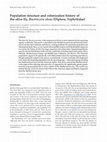
Molecular Ecology, 2005
The olive fly, Bactrocera oleae, is the major pest of olives in most commercial olive-growing reg... more The olive fly, Bactrocera oleae, is the major pest of olives in most commercial olive-growing regions worldwide. The species is abundant in the Mediterranean basin and has been introduced recently into California and Mexico, creating problems for quarantine protection and international trade. Here, we use nuclear microsatellite markers and mitochondrial sequences to examine the history of olive fly range expansion and colonization. Sampled populations span the current distribution of the olive fly worldwide, including South and Central Africa, Pakistan, Mediterranean Europe and Middle East, California, and Mexico. The Pakistani populations appear to be genetically well differentiated from the remaining populations, though rooting the origins of the species is problematic. Genetic similarity and assignment tests cluster the remaining populations into two genetic groups — Africa and a group including the Mediterranean basin and the American region. That Africa, and not the Mediterranean, is the origin of flies infesting cultivated olive is supported by the significantly greater genetic diversity at microsatellite loci in Africa relative to the Mediterranean area. The results also indicate that the recent invasion of olive flies in the American region most likely originated from the Mediterranean area.

Arthropod Structure & Development, 2011
Sperm ultrastructure and spermiogenesis of the dipluran Japygidae (Japyx solifugus, Metajapyx bra... more Sperm ultrastructure and spermiogenesis of the dipluran Japygidae (Japyx solifugus, Metajapyx braueri and Occasjapyx japonicus) and Campodeidae (Campodea sp.) were studied with the aim of looking for potential characters for the reconstruction of the phylogenetic relationships of basal hexapods. Both Japygidae and Campodeidae share a common sperm axonemal model 9 þ 9 þ 2, provided with nine accessory microtubules. These microtubules, however, after their formation lose the usual position around the 9 þ 2 and migrate between the two mitochondria. In Japygidae, four of these microtubules are very short and were observed beneath the nucleus after negative staining and serial sections. Accessory microtubules have 13 protofilaments in their tubular wall. Diplura have a sperm morphology which is very different from that of the remaining Entognatha (Protura þ Collembola). On the basis of the present results, the presence of accessory microtubules suggests that Diplura are the sister-group of the Insecta s.s.. Moreover, Japygidae and Campodeidae differ with regards to the relative position of the sperm components, the former having the axoneme starting from beneath the nucleus (above which sits the short acrosome), while the latter having a long apical acrosome and a nucleus running parallel with the proximal part of the axoneme. The present study also allowed to redescribe the male genital system of Japyx.
BMC Genomics, 2008
Background: Mitogenomics data, i.e. complete mitochondrial genome sequences, are popular molecula... more Background: Mitogenomics data, i.e. complete mitochondrial genome sequences, are popular molecular markers used for phylogenetic, phylogeographic and ecological studies in different animal lineages. Their comparative analysis has been used to shed light on the evolutionary history of given taxa and on the molecular processes that regulate the evolution of the mitochondrial genome. A considerable literature is available in the fields of invertebrate biochemical and ecophysiological adaptation to extreme environmental conditions, exemplified by those of the Antarctic. Nevertheless, limited molecular data are available from terrestrial Antarctic species, and this study represents the first attempt towards the description of a mitochondrial genome from one of the most widespread and common collembolan species of Antarctica.
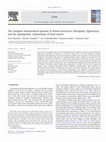
Gene, 2009
In this study, the complete sequence of the mitochondrial DNA (mtDNA) of Atelura formicaria (Hexa... more In this study, the complete sequence of the mitochondrial DNA (mtDNA) of Atelura formicaria (Hexapoda: Zygentoma) is described. The molecule is 15.205 bp in length and it is the third complete mt genome sequenced from the Zygentoma. The genome organization conforms with the putative ancestral insect gene arrangement. All protein coding genes use standard initiation codons (methionine and isoleucine). The exception is nad4 that starts with GTG, a codon used for this purpose in other insect species. A peculiar strand skew bias is observed, given that the PCGs encoded on the J-strand contain more thymines than adenines and more cytosines than guanines. This trend in nucleotide composition has been observed also in the "firebrat" Thermobia domestica (Zygentoma, Lepismatidae), but differs from that of the majority of hexapod species, including Tricholepidion gertschi (Zygentoma, Lepidotrichidae), where adenines and cytosines outnumber thymines and guanines. The presence of structural elements in the control region is also discussed, with emphasis on their potential implications in the regulation of replication and/or transcription of the mitochondrial genome. A mitogenomic phylogenetic analysis, centered on the internal relationships within Zygentoma and on the position of Microcoryphia and Zygentoma among Ectognatha, is performed.

Zoomorphology, 2001
Light and electron microscopic evidence is provided to describe a new example of a postzygotic se... more Light and electron microscopic evidence is provided to describe a new example of a postzygotic sex-determination system in two collembolan species, Bourletiella arvalis and B. hortensis. In B. arvalis, where chromosome number could be assessed, both sexes are homogametic (n=6) and all zygotes have an identical chromosome composition (2n=12). However, male embryos develop after the loss of two sex chromosomes, making the male genotype 2n=10 (4AAX10X20). On the other hand, female embryos develop if the zygote retains all chromosomes and the female genetic system is, therefore, 4AAX1X1X2X2 (2n=12). As an apparent consequence of the lack of two chromosomes in the male germ cells, spermatogenesis is aberrant. At the first meiotic division, in fact, the two resulting secondary spermatocytes receive a different number of chromosomes: six and four. The cells which receive six chromosomes (one haploid set of four autosomes and two sex chromosomes) proceed through the meiotic process and the two spermatids generated produce two spermatozoa by a normal spermiogenesis. The cells receiving only four chromosomes do not undergo the second meiotic division and soon degenerate. The degenerating cells can be considered a morphological marker for this process, as they are easily recognizable at the electron microscope from the functional secondary spermatocytes by the appearance of the nucleus (totally condensed), the reduction of the cytoplasm (limited to a thin layer surrounding the nucleus), and the lack of most cytoplasmic organelles (with the exception of a couple of centrioles). Electron microscopic evidence has been collected for both species, allowing to extend the same process to B. hortensis, even if chromosomes could not be counted in this species. Therefore, as a result of the spermatocyte elimination, the efficiency of spermatogenesis is reduced to 50%. This process is identical to that observed in other collembolan species of the suborder Symphypleona, and it is suggested that it represents a synapomorphic feature uniting the families Dicyrtomidae, Sminthuridae and Bourletiellidae (Sminthuriformia). It is also suggested that the process is related with the finding of a distorted sex ratio in natural populations and, possibly, with the evolution of parthenogenesis. This hypothesis is supported by the fact that chromosome pairing and genetic recombination occurs only during female meiosis, while chromosomes do not pair during male meiosis.
Insect Molecular Biology, 2009
Acetylcholinesterase (AChE) is a key enzyme of the cholinergic nerve system. Of the two forms fou... more Acetylcholinesterase (AChE) is a key enzyme of the cholinergic nerve system. Of the two forms found in insects, the predominant one is active in the synapses and is the target of organophosphate and carbamate insecticides, while the role of the second is currently unknown. Two acetylcholinesterase cDNAs from the basal hexapod Orchesella villosa have been characterized and compared with others reported form insects. One form conforms well to the typical structure, while the other is characterized by an unusual 3′ region. No amino acid mutation could be directly associated with known resistance mutations in other insect species or to a clear signal of selection in the distribution of alleles, although the action of some population process is suggested.
BMC Evolutionary Biology, 2007
Italian Journal of Zoology, 1995
Two independent genetic markers (allozymes and mitochondrial DNA sequences) were used to demonstr... more Two independent genetic markers (allozymes and mitochondrial DNA sequences) were used to demonstrate that Isotomurus palustris palustris and Isotomurus palustris maculatus (Collembola, Isotomidae), interpreted either as varieties or subspecies by the various authors, are, actually, well differentiated species. Specimens were collected sympatrically in five different sampling sites in Italy and southern France, and, in all of them, the two forms were fixed for alternative alleles at some enzyme loci. The absence of hybrids demonstrates that the two species, discriminated morphologically by body pigmentation, do not cross. The rate of sequence divergence of the mitochondrial COII gene confirms a significant degree of differentiation.

Gene, 2010
Collembola are one of the few hexapod groups adapted to live in the harsh environmental condition... more Collembola are one of the few hexapod groups adapted to live in the harsh environmental conditions of Antarctic terrestrial ecosystems. Diversity is limited to a few species that can be very abundant in coastal deglaciated sites. A remarkable lack of overlap in Collembola species composition is evident between Western and Eastern Antarctica, and Friesea grisea is currently the only species whose distribution is thought to span these two main regions of the continent. However, our analysis of the complete sequences of the mitochondrial genomes from specimens obtained from each of the two regions showed unexpected genetic divergence, well above the average levels observed between populations belonging to the same species, and so indicating that these are actually separate species, despite their lack of distinguishing morphology. Detailed analysis of the two genomes showed the presence of a non-coding region observed between trnS (uga) and nad1. Other features of these mitochondrial genomes, such as base compositional bias, secondary structure features of tRNAs and the presence of regulatory elements in the control region, are described and discussed from an evolutionary standpoint.
Insect Molecular Biology, 2003
The complete sequence of the olive fly ( Bactrocera oleae ) mitochondrial genome has been determi... more The complete sequence of the olive fly ( Bactrocera oleae ) mitochondrial genome has been determined. Two independent haplotypes, from flies of distant geographical origin (Italy and Portugal) were completely sequenced. The molecule is 15 815 bp long, and shows the gene content and organization typical of insects, namely thirteen protein coding genes (PCGs) encoding proteins involved in oxidative phosphorylation, two rRNAs, twenty-two tRNAs and a long (949 bp) noncoding region. The genomes of the two fly specimens share the same arrangement, differing by a mere thirtyone point mutations. The differences are mostly transitions (26) and synonymous substitutions in PCGs (21 ). The two new sequences are compared with others already present in the database.
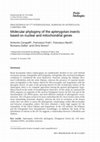
Pedobiologia, 2000
M Mo ol le ec cu ul la ar r p ph hy yl lo og ge en ny y o of f t th he e a ap pt te er ry yg go o... more M Mo ol le ec cu ul la ar r p ph hy yl lo og ge en ny y o of f t th he e a ap pt te er ry yg go ot ta an n i in ns se ec ct ts s b ba as se ed d o on n n nu uc cl le ea ar r a an nd d m mi it to oc ch ho on nd dr ri ia al l g ge en ne es s Summary Basal hexapodan orders (Apterygota) are traditionally divided in two well defined taxonomic groups, Entognatha and Ectognatha. Entognathy (the enclosed mouthparts condition) is considered the most distinctive character joining the Ellipura (Pro-tura+Collembola) with the order Diplura, whereas the presence of exposed mouthparts (ectognathy) is the feature shared by Microcoryphia and Zygentoma with the pterygote insects. In spite of the growing interest for the evolutionary history of the Apterygota, there is no complete agreement among the general phylogenetic hypotheses based on the study of morphological characters. In this study we analyzed the DNA sequence of segments of the nuclear Elongation Factor-1α (EF-1α) and of the mitochondrial 12S rRNA genes, and used different methods of phylogenetic reconstruction. The 12S gene seems to be more suited than the EF-1α to resolve some of the most outstanding systematic disputes, whereas the lack of resolution at the deeper nodes does not allow to assess the phylogenetic relationships within Microcoryphia and between ectognathan orders. We have obtained a fairly high support for the monophyly of the orders Diplura and Zygentoma. In the 12S analysis, the Ellipura and the Entognatha form monophyletic assemblages. In addition, the study of the distribution of introns in the EF-1α suggests a relationship between Collembola and Diplura.
Uploads
Papers by Antonio Carapelli
of different species adapted to the extreme Antarctic environment. The genus Folsomotoma includes nine species
mainly distributed in Antarctic and subantarctic areas and a few additionally from Australia and South America. We herein
designate the neotype of Folsomotoma octooculata (Willem 1901) and redescribe its morphological characters with particular
emphasis on the sensory and ordinary chaetotaxy. Furthermore, based on analyses of both our new and previously
published morphological data for F. octooculata, we propose a systematic key of the species for the genus.
genetic variability between Cryptopygus terranovus populations, a springtail species endemic to
Antarctica, until recently named Gressittacantha terranova. This study expands these biogeographical
surveys using additional analytical techniques, providing a denser haplotype dataset and a wider
sampling of localities. Specimens were collected from 11 sites across Victoria Land and sequenced for the
cytochrome c oxidase subunit I mitochondrial gene (cox1). Haplotypes were used for population
genetics, demographic, molecular clock and Bayesian phylogenetic analyses. Landscape distribution
and clustering of haplotypes were also examined for the first time in this species. Only three (out of 67)
haplotypes are shared among populations, suggesting high genetic structure and limited gene flow
between sites. As in previous studies, the population of Apostrophe Island has a closer genetic similarity
with those of the central sites, rather than with its neighbours. Molecular clock estimates point to early
differentiation of haplotypes in the late/mid-Miocene, also supporting the view that C. terranovus is a
relict species that survived on the Antarctic continent during the Last Glacial Maximum. The present
genetic composition of populations represents a mixture of ancient and more recent haplotypes,
sometimes occurring in the same localities.
https://euraxess.ec.europa.eu/jobs/hosting/open-positions-marie-curie-individual-fellowships-msca-if-beneficiarie
Research activities span from molecular phylogenetics of Arthropods to population genetics of Antarctic species and OMICS data. Further info to be requested at: antonio.carapelli@unisi.it
of different species adapted to the extreme Antarctic environment. The genus Folsomotoma includes nine species
mainly distributed in Antarctic and subantarctic areas and a few additionally from Australia and South America. We herein
designate the neotype of Folsomotoma octooculata (Willem 1901) and redescribe its morphological characters with particular
emphasis on the sensory and ordinary chaetotaxy. Furthermore, based on analyses of both our new and previously
published morphological data for F. octooculata, we propose a systematic key of the species for the genus.
genetic variability between Cryptopygus terranovus populations, a springtail species endemic to
Antarctica, until recently named Gressittacantha terranova. This study expands these biogeographical
surveys using additional analytical techniques, providing a denser haplotype dataset and a wider
sampling of localities. Specimens were collected from 11 sites across Victoria Land and sequenced for the
cytochrome c oxidase subunit I mitochondrial gene (cox1). Haplotypes were used for population
genetics, demographic, molecular clock and Bayesian phylogenetic analyses. Landscape distribution
and clustering of haplotypes were also examined for the first time in this species. Only three (out of 67)
haplotypes are shared among populations, suggesting high genetic structure and limited gene flow
between sites. As in previous studies, the population of Apostrophe Island has a closer genetic similarity
with those of the central sites, rather than with its neighbours. Molecular clock estimates point to early
differentiation of haplotypes in the late/mid-Miocene, also supporting the view that C. terranovus is a
relict species that survived on the Antarctic continent during the Last Glacial Maximum. The present
genetic composition of populations represents a mixture of ancient and more recent haplotypes,
sometimes occurring in the same localities.
https://euraxess.ec.europa.eu/jobs/hosting/open-positions-marie-curie-individual-fellowships-msca-if-beneficiarie
Research activities span from molecular phylogenetics of Arthropods to population genetics of Antarctic species and OMICS data. Further info to be requested at: antonio.carapelli@unisi.it